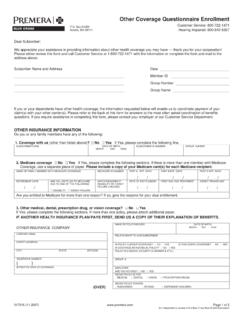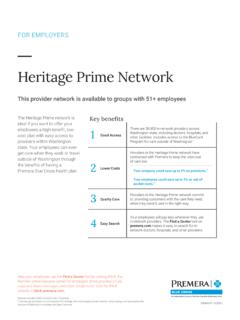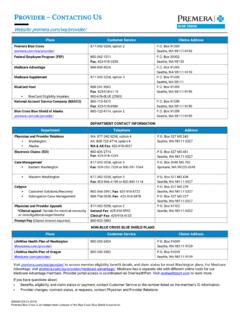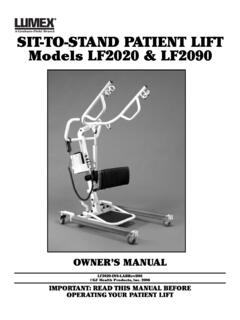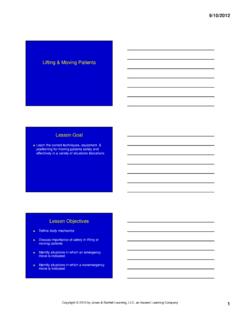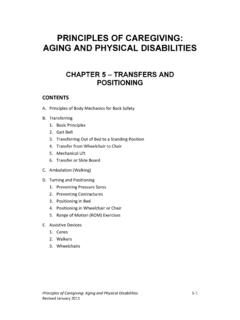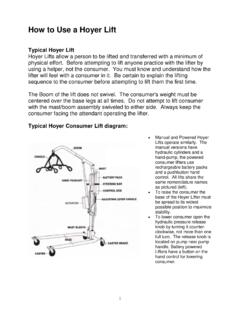Transcription of 1.01.519 Patient Lifts, Seat Lifts and Standing Devices
1 UTILIZATION MANAGEMENT GUIDELINE Patient Lifts , Seat Lifts and Standing Devices Effective Date: Feb. 5, 2021 Last Revised: Oct. 13, 2020 Replaces: N/A RELATED POLICIES/GUIDELINES: Wheelchairs (Manual or Motorized) Power Operated Vehicles (Scooters) (Excluding Motorized Wheelchairs) Non-covered Services and Procedures Select a hyperlink below to be directed to that section. COVERAGE GUIDELINES | DOCUMENTATION REQUIREMENTS | CODING RELATED INFORMATION | EVIDENCE REVIEW | REFERENCES | HISTORY Clicking this icon returns you to the hyperlinks menu above. Introduction A Patient lift is used to safely move a Patient who is unable to move themselves from a bed to a chair or between other locations. Patient Lifts are used in hospitals, nursing homes, and in home health care. Patient Lifts come in different types. Some are operated by hydraulic power, others are electric, and yet others combine support with the Patient s own strength. They may be either a sling lift or a sit-to- stand lift.
2 This guideline explains when these items are covered. Note: The Introduction section is for your general knowledge and is not to be taken as policy coverage criteria. The rest of the policy uses specific words and concepts familiar to medical professionals. It is intended for providers. A provider can be a person, such as a doctor, nurse, psychologist, or dentist. A provider also can be a place where medical care is given, like a hospital, clinic, or lab. This policy informs them about when a service may be covered. Coverage Guidelines If benefit coverage for durable medical equipment is available, the following criteria apply. Equipment Coverage Guidelines Non-electric Patient Lifts (E0630) Mechanical/hydraulic Patient Lifts (non-electric) may be considered medically necessary durable medical equipment (DME) when ALL of the following criteria are met: Page | 2 of 10 Equipment Coverage Guidelines Transferring the member between the bed and a chair, wheelchair, or commode requires the assistance of more than one person AND Without the use of a Patient lift, the member would be bed-confined A canvas or nylon sling or seat for a hydraulic or mechanical lift is considered medically necessary as an accessory when ordered as a replacement for an approved equipment item (E0621).
3 Multi-positional Lifts -(E1035, E1036) A multi-positional transfer system is considered medically necessary when criteria are met for the hydraulic or mechanical lift, (noted above), AND the Patient requires supine positioning for transfers Electric Lifts (E0635) An electric lift mechanism is considered a convenience item; therefore, payment is not allowed as it is a contractual exclusion. Non-electric seat lift mechanisms (E0629) Mechanical/hydraulic seat lift (non-electric) mechanisms may be considered medically necessary durable medical equipment (DME) when ALL of the following criteria are met: The member has severe arthritis of the hip or knee or has a severe neuromuscular disease AND The seat lift mechanism is prescribed to improve health status or arrest or retard deterioration in the member s condition AND The member is incapable of Standing up from any regular chair (with or without arms) in the home AND Once the member stands, he/she has the ability to ambulate.
4 Spring-release seat lift Devices are considered not medically necessary. Page | 3 of 10 Equipment Coverage Guidelines Note: A spring-release mechanism uses a catapult-type motion that jolts the member from a seated to a Standing position and does not facilitate a safe return to a seated position. Electric seat lift mechanisms or chairs (E0170, E0627, E0635, E0636) Electric lift chairs or powered seat lift mechanisms are considered convenience items; therefore, payment is not allowed as it is a contractual exclusion. Note: Coverage is limited to the mechanical (non-electric) seat-lift mechanism alone (see above), even if it is incorporated into a chair. A chair is considered furniture. Furniture does not meet the definition of Durable Medical Equipment (DME). DME is defined as mechanical equipment that can stand repeated use and is used in connection with the direct treatment of an illness or injury. Standing Devices (E0638, E0641, E0642) Mechanical, non-powered, Standing Devices may be considered medically necessary durable medical equipment (DME) when ALL of the following criteria are met: The Patient is unable to ambulate or stand independently because of a neuromuscular condition but has sufficient residual strength in the lower extremities (eg, hips and legs) to allow for use of the device AND A Standing position cannot be successfully achieved even with the use of physical therapy or other assistive Devices AND The Patient has completed appropriate Standing device training and has demonstrated an ability to safely use the device Powered or electric/battery operated Standing Devices are considered convenience items; therefore, payment is not allowed as it is a contractual exclusion.
5 Non-covered items The following items are not primarily medical in nature, and are considered home/vehicle modifications or are considered convenience items; therefore, payment is not allowed as they are contractual exclusions. Bathroom Lifts and /or toilet Lifts (E0170, E0171, E0172, E0625) Ceiling Lifts (E0640) Page | 4 of 10 Equipment Coverage Guidelines Combination sit-to stand frame/table systems (E0637) Lifting, Standing , or positioning Devices that involve fixtures to real property (E0639, E0640) Stairway chair/stair Lifts Stair gliders Platform Lifts Van Lifts Documentation Requirements The Patient s medical records submitted for review for all conditions should document that medical necessity criteria are met. The record should include the following: Office visit notes that contain the relevant history and physical: o Supporting the need for requested Lifts , seat Lifts , or Standing Devices o In addition, for Standing Devices the documentation needs show that that the Patient has completed appropriate Standing device training and has demonstrated an ability to safely use the device Coding Code Description HCPCS E0621 Sling or seat, Patient lift, canvas or nylon E0629 Separate seat lift mechanism for use with Patient owned furniture nonelectric E0630 Patient lift.
6 Hydraulic or mechanical, includes any seat, sling, strap(s), or pad(s) E0637 Combination sit and stand system, any size including pediatric, with seat lift feature, with or without wheels E0638 Standing frame system, one position (eg, upright, supine or prone stander), any size including pediatric, with or without wheels E0639 Patient lift, moveable from room to room with disassembly and reassembly, includes all components/accessories E0641 Standing frame system, multi-position (eg, three-way stander), any size including pediatric, with or without wheels Page | 5 of 10 Code Description E0642 Standing frame system, mobile (dynamic stander), any size including pediatric E0985 Wheelchair accessory, seat lift mechanism E1035 Multi-positional Patient transfer system, with integrated seat, operated by care giver, Patient weight capacity up to and including 300 lbs. E1036 Multi-positional Patient transfer system, extra-wide, with integrated seat, operated by caregiver, Patient weight capacity greater than 300 lbs.
7 Note: CPT codes, descriptions and materials are copyrighted by the American Medical Association (AMA). HCPCS codes, descriptions and materials are copyrighted by Centers for Medicare Services (CMS). Related Information Definition of Terms Ceiling Lifts (E0640): Ceiling Lifts are typically attached to tracks installed directly into the ceiling in the home allowing easier Patient transfer. Most of these Devices are motorized though some are manually operated. The tracks can be located in more than one room of the home, allowing some portability. Manufacturers propose that positioning is easier with ceiling Lifts than with floor-mounted Lifts , and, if motorized, the ceiling Lifts can be used independently by the Patient . Fixed motorized Lifts , however, are considered a home modification and a convenience item. (Not covered according to contract). Miscellaneous Lifts : Stairway chair Lifts and stair gliders are Devices attached to a track on a stairway to transfer from one level of the home to another on a chair or lift seat.
8 They can be used on straight, curved or spiral stairs to aid in mobility throughout the home. Other commonly used lift Devices , including, but not limited to, van Lifts (used to lift wheelchairs in and out of vans), wheelchair Lifts (used to provide access to stairways or automobiles) and platform Lifts facilitate transportation within the home or in and out of the home and are not primarily medical in nature. Patient Lifts (E0630,E0639, E1035, E1036, E0639, E0640): Patient Lifts are those Devices either mechanical or electric that assist a caregiver in transferring a Patient safely back and forth from a bed to a chair in cases where the Patient is immobilized and would otherwise be confined to bed. (eg, Hoyer lift with a sling and/or seat that is placed under the Patient that supports them in the lifting device). A multi-positional transfer system is used to assist the caregiver(s) in Page | 6 of 10 transferring an individual who requires the use of a lift along with supine positioning for transfer.
9 Patient lift, movable from room to room (E0639) describes a device in which the lift mechanism is part of a floor to ceiling pole system, not permanently attached to the floor and ceiling, which is used in a room other than the bathroom and Patient lift, fixed system (E0640) describes a device in which the lift mechanism is attached to permanent ceiling tracks or a wall mounting system and which is used in a room other than the bathroom, both are considered deluxe, convenience items and are not covered. Patient Lifts Toilet/tub (E0170, E0171, E0625): A Patient lift for a toilet/tub, is a single-purpose assistive device for transferring patients from the toilet/tub to another seat (eg, wheelchair). It is generally used for patients who are unable to ambulate. Bathroom Lifts used for transferring a Patient onto a toilet or into a tub/shower are considered self-help and convenience items. (Not covered according to most contracts). Residential/Home Modifications: Stair Lifts , stairway elevators, platform Lifts , ceiling Lifts and other structural changes or additions are considered home modifications and are not covered.
10 Seat Lift Mechanisms (E0627, E0629): Seat lift mechanisms are those Devices either mechanical or electric, controlled by the individual that operate smoothly and successfully assist the individual in Standing up and sitting down without other assistance. Some seat lift Devices are separate mechanisms that are placed under a chair, some are placed on the seat of the chair and some are incorporated (built-in) to furniture such as a chair/recliner. Standing Devices (E0637, E0638, E0641, E0642): Standing Devices are also known as Standing frames, standers, and others. This Standing technology provides alternative positioning to sitting in a wheelchair by supporting the person in a Standing position. A seat lift mechanism or sling is placed under the Patient to gently raise the person from a sitting position to a Standing position. Upright standers are used primarily in the vertical position by individuals who have fair to good trunk and head control. Studies have proposed that Standing Devices improve bone mineral density, bowel and bladder functioning, incidence of contractures and improve skin integrity.

